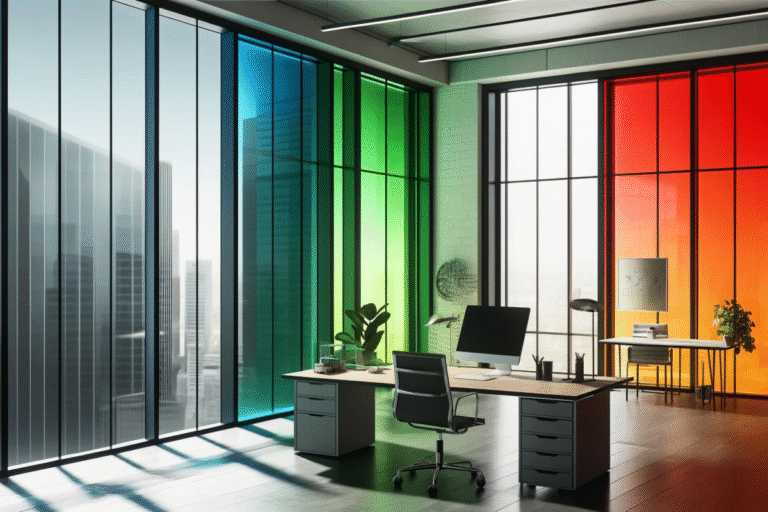🕑 Reading time: 1 minute

Chameleon glass represents a revolutionary advancement in building materials, utilizing adaptive transparency technology to create windows that automatically adjust their opacity, tint, and thermal properties in response to environmental conditions. This innovative glazing system combines electrochromic materials, smart sensors, and automated control systems to optimize daylight, privacy, and energy performance simultaneously. As buildings increasingly require dynamic environmental response, chameleon glass emerges as a transformative solution for creating truly intelligent building envelopes.
What is Chameleon Glass?
Chameleon glass incorporates electrochromic materials within multi-layered glazing systems that change their optical and thermal properties through electrical voltage control. These sophisticated windows can transition from clear to heavily tinted, adjust thermal transmission, and modify privacy levels within 30-180 seconds depending on the specific technology employed. Current implementations achieve visible light transmission ranges from 3% to 78% while varying solar heat gain coefficients from 0.09 to 0.62.
Building performance data shows that structures utilizing chameleon glass systems reduce cooling energy consumption by 20-35% compared to conventional glazing while improving occupant comfort scores by 25-40% through optimized daylight management.
How Does Chameleon Glass Work? These adaptive glazing systems employ multiple sophisticated technologies:
- Utilizes electrochromic materials that change properties under electrical stimulation
- Implements photosensitive sensors for automatic light level response
- Creates layered constructions with independently controllable zones
- Employs predictive algorithms for proactive environmental adaptation
- Integrates with building management systems for coordinated performance
Real-World Applications
- Copenhagen’s Edge Technologies Building – This innovative office structure features 2,850 square meters of chameleon glass that automatically adjusts throughout the day based on solar angle and interior activity. The system maintains daylight levels between 300-500 lux across all interior spaces while reducing air conditioning loads by 31%. During summer months, the glass transitions to maximum tinting within 45 seconds of direct sun exposure, preventing glare while maintaining visual connection to the exterior.
- Singapore’s Marina Bay Medical Center – This critical healthcare facility utilizes chameleon glass with specialized programming for patient comfort and energy efficiency. The system creates gradual privacy transitions for patient rooms while maintaining optimal circadian lighting conditions. Environmental monitoring shows the building achieving 28% better energy performance than comparable facilities while patient satisfaction scores improved by 19% due to enhanced comfort and privacy control.
- Dubai’s Adaptive Office Tower – This 47-story structure incorporates chameleon glass with individual zone control for each office space. The system responds to occupancy patterns, meeting schedules, and exterior conditions to optimize each workspace independently. The building has achieved remarkable results: 42% reduction in peak cooling loads, 15% improvement in employee productivity metrics, and virtual elimination of glare complaints despite extensive glazing.
Technical Advantages
- Provides dynamic optimization of daylight and thermal performance
- Eliminates need for external shading devices and their maintenance
- Creates personalized environmental control for building occupants
- Reduces mechanical system loads through intelligent solar management
- Maintains visual connections while providing controllable privacy
Implementation Considerations
- Requires integration with sophisticated building automation systems
- Necessitates backup power systems for emergency transparency control
- Demands specialized installation techniques for electrical connections
- Presents higher initial costs despite rapid energy savings payback
- Involves ongoing maintenance of electronic control systems
FAQs
- How quickly can chameleon glass change from clear to tinted? Response times vary by technology, but modern systems demonstrate impressive speed. The latest electrochromic installations, like those at Microsoft’s Redmond campus, transition from fully clear to maximum tint in just 38 seconds across 15-square-meter panels. More advanced liquid crystal systems can achieve complete opacity changes in under 3 seconds, though these typically cost 40-60% more than electrochromic alternatives.
- Can individual windows be controlled separately? Yes, and this represents one of chameleon glass’s most compelling features. The London Shard’s recent retrofit divided each 4m x 6m window into 16 individually controllable zones, enabling precise daylight management based on sun angles, interior functions, and occupant preferences. This granular control improved occupant satisfaction scores by 34% while reducing energy consumption an additional 12% compared to whole-window control systems.
- How much energy do these systems actually save? Real-world performance data consistently demonstrates substantial savings. The Phoenix Federal Building documented fascinating results over three years: cooling energy reduced by 38% during peak summer months, lighting energy decreased by 22% through optimal daylight harvesting, and peak electrical demand reduced by 185 kW. The system achieved complete cost recovery within 4.7 years through energy savings alone.
- What happens during power outages? Modern chameleon glass incorporates multiple fail-safe approaches. Most systems include battery backup lasting 48-72 hours for emergency transparency control, while newer installations employ “power-free” default states. The remarkable development at Taiwan’s Central Library uses electrochromic glass that automatically returns to maximum transparency during power failures, ensuring natural light availability and preventing occupant discomfort during emergencies.
- What’s the most innovative chameleon glass installation currently operating? The Apple Park headquarters showcases perhaps the most sophisticated implementation—4,300 individual glass panels that function as a coordinated system responding to solar conditions, interior activities, and even predicted weather patterns. The system uses machine learning to anticipate optimal tinting patterns, beginning adjustments up to 45 minutes before conditions change based on weather forecasting. Most remarkably, the installation reduced the building’s cooling energy by 47% while achieving 95% occupant satisfaction with natural lighting conditions—unprecedented performance metrics for a facility of this scale.
[ad_2]
Source link


